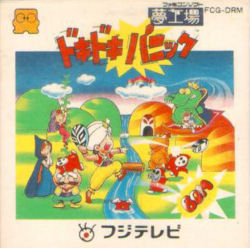Yume Kōjō: Doki Doki Panic

| |
| Yume Kōjō: Doki Doki Panic | |
| Developer | Nintendo EAD |
| Publisher | Fuji Television |
| System | Famicom Disk System |
| Release Date | JP July 10, 1987 |
| Genre | Action |
Yume Kōjō: Doki Doki Panic (translated to Dream Factory: Heart-Pounding Panic) is a game designed by Shigeru Miyamoto for the Famicom Disk System. The game is best known for its remake as Super Mario Bros. 2.
Story[edit]
The game follows a family as they travel into a magical book world that two little children have become lost inside of. The evil Mamu had taken the children to his dream factory in the seventh world. The game is notable for its largely Arabian inspiration seen in the design of the main characters, as well as many of the enemies, such as Pidgit's flying carpet and the genie's lamp to enter Sub-Space.
Gameplay[edit]
The game is a platformer broken up into six worlds with four levels each and one final world with only two levels. For each level the character has to reach the end of the level and finish it by fighting a boss or simply finding the glowing sphere that will open a large face into which the character can climb into and enter a bonus round to earn lives. Traversing each level requires finding keys, searching inside vases, opening doors, or riding a rocket to a higher area.
The game had four playable characters and to see the ending of the game, each character had to beat every level. Each character had their own stats as well.
- Papa: Quick and nimble with a 5/5 in strength and speed, but only a 2/5 jump.
- Mama: The best jumper of the four with a 5/5. Her speed and power are only 3/5.
- Imajin: A completely balanced character. His jump, speed, and power are all at 4/5.
- Lina: Generally unexceptional in stats, with a 2/5 in speed and power and a 3/5 in jump. However, she has the ability to float for a few seconds after reaching the height of her jump.
Remakes[edit]
In Japan, the original Super Mario Bros. 2 was released with minimal input by Miyamoto and was designed largely by Takashi Tezuka instead. The game was built on the Super Mario Bros. engine and used the same graphics, but the game was much harder than the original. Nintendo felt that the game might be too difficult for American audiences, so Doki Doki Panic was altered to the international Super Mario Bros. 2.
Several changes were made to the game to not only made it appropriate for American audiences, but also to make it consistent with what was already established in the Mario Brothers series. Most of the enemies were left unchanged, but the main cast was altered to popular Mario characters. Papa was changed to Toad, Mama to Luigi, Imajin to Mario, and Lina to Princess Toadstool.
Several other graphical and gameplay features were altered. Many of the sprites were animated, enemies given additional frames, and items changes to fit the Mario franchise. Gameplay elements were added, such as the ability to run and the characters shrinking to half their size when reduced to only one heart.
Legacy[edit]
The game was created as part of the Yume Kōjō (Dream Factory) festival '87 event hosted by Fuji Television. The four main characters of the game were in fact the mascots of the Yume Kōjō festival and owned by Fuji Television. However the rest of the game - the enemies, bosses, and scenarios were all Nintendo's creation. For this reason, Nintendo was able to reuse everything from the game, save for Papa, Mama, Imajin, and Lina.
Although the game never had a sequel or international release, many of the enemies in the game carried on their legacy in the Mario Brothers series due to the game's remake as Super Mario Bros. 2. The main cast of characters was never used again due to the ownership of Fuji Television.